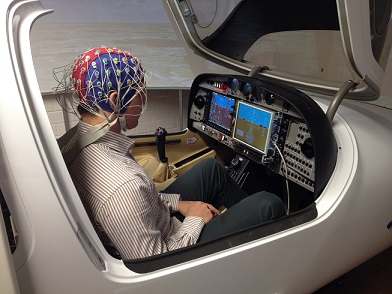Mind control takes flight

Related topics
Innovation Transport Smart, green and integrated transport Germany Netherlands Portugaldate: 30/06/2015
Project: Brain controlled aircraft flight using m...
acronym: BRAINFLIGHT
See also: CORDIS
The BRAINFLIGHT project’s demonstration of a control system to interpret a human’s brain signals and convert them into commands took place at a small airport near Lisbon, Portugal in May 2014.
An operator wearing a skin-tight head cap that picks up electric signals from brain activity was able to control the drone's path by thinking about the movements he wanted it to take during the live test. The drone was a specially equipped model of a plane about half the length of a human.
Essentially, the electricity flowing through a pilot's brain acts as an input to the drone's control system to follow a flight path, says project coordinator Andre Oliveira, of Tekever in Portugal.
The demonstration results suggest that the technology could eventually be used to help pilots fly small aeroplanes and even large cargo jets more efficiently – increasing safety in the air.
A more developed system, once authorised for use, could allow pilots to concentrate more than is currently possible on evaluating their current flight situation, while another part of their brain focuses simultaneously on controlling the plane. The system, in effect, transforms thoughts into an additional ‘hand’, or way to control flight.
The project suggests that larger jets, such as cargo planes, could even be controlled this way without the need for a crew on board. But a fully developed system would take some time before it could become operational “during this century”, says Oliveira. Much more development work is needed, along with testing and regulatory clearance, before it can be put into commercial use.
“This is an amazing high-risk and high-payoff project, with a long-term impact that will require a lot more development,” he adds. “We truly believe that BRAINFLIGHT represents the beginning of a tremendous step change in the aviation field, empowering pilots and reducing risks.”
From theory to flight
An increasing proportion of a pilot’s workload is related to managing flight, which requires checking instruments, verifying aircraft systems, navigating, observing the surroundings, and carrying out a number of pre-defined procedures – all while flying an aircraft.
When pilots have to do both types of activities at the same time, such as when landing or flying in poor visibility, they need to divide their attention and cognitive skills between those different activities and become more prone to making errors, says Oliveira.
BRAINFLIGHT based its research on previous studies that revealed how the brain’s neuron activity is capable of providing enough data to enable the control of electronic devices.
The researchers adapted high-performance electroencephalogram (EEG) technology so it could issue instructions to software that can guide an aircraft. The project also investigated the best approaches to train pilots to use the technology.
Test subjects were trained to use the system over a number of months until they were able to control a circle on a computer screen, moving it up or down using only their thoughts, simulating steering a drone.
The subjects then successfully tested the system in a flight simulator for the Diamond DA42, a four-seat, propeller-driven aircraft. The later demonstration in Portugal using a drone controlled by a pilot on the ground marked the project’s conclusion in May 2014.
Tekever is continuing to develop the demonstration system. The company says it believes people will eventually be able to “pilot aircraft just like they perform everyday activities like walking or running”.
The technology could be adapted in the short term to enable people with physical disabilities to control aircraft, opening the way for them to become pilots, says Oliveira.
Another area of application is advanced prosthetics – the technology could enable people with severe physical disabilities to interact with their surroundings more easily. The project results could also be adapted to control other complex systems, like cars, boats and trains, says Oliveira.
Video: Brain controlled drone shown off by Tekever in Lisbon
